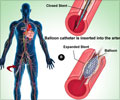A new research shows that identifying the presence or absence of coronary artery calcium (CAC) in a patients' arteries can help determine their future risk of a heart attack.

‘People who showed CAC in the CT/PET scan are more likely to get a heart attack within the next 90 days than those who did not show calcification.’





Results of the study were presented at the American College of Cardiology Scientific Sessions in Atlanta on March 16, 2019. For the study, researchers identified 5,547 patients without a history of coronary artery disease who came to Intermountain Medical Center with chest pain between April 2013 and June 2016.
These patients had undergone PET/CT scans to assess for ischemia, a disruption of normal blood flow through the heart arteries to the muscle tissues of the heart. This scan also looks for the presence of CAC, which are calcium deposits on the walls of the heart's arteries, indicating atherosclerosis, or plaque, the hallmark of heart disease. The researchers then examined patients' medical outcomes for up to the next four years.
Researchers found that patients whose scans revealed CAC were at higher risk of having a heart event within 90 days compared with patients whose PET/CT showed they had no CAC. Researchers also found that patients with CAC were also more likely over the following years to have high-grade obstructive coronary artery disease, revascularization surgery, and/or other major adverse cardiac events than patients who had no coronary artery calcium.
The findings can be used in two different ways, said Le.
Advertisement
Second, CAC isn't easily visually identifiable at low or moderate levels in the arteries without a formal scan. Checking patients who are not actively found to be experiencing a heart event but who have suspicious symptoms when they come to the ED can help physicians identify who is at risk for a future event. This allows for early initiation of risk reducing lifestyle changes in those found to have CAC to avoid future events.
Advertisement
Future studies are needed to demonstrate whether a CAC first strategy in these symptomatic patients will better identify those who should have further stress testing as well as improve patient education and early implementation of risk reducing strategies.
Source-Eurekalert















